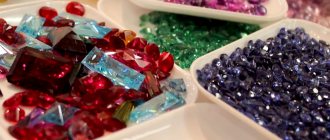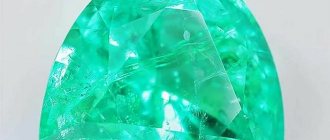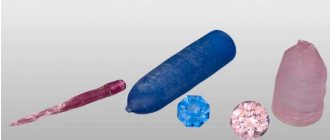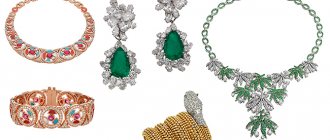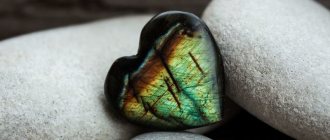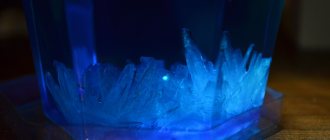- Amber with insects - what is it and how does it appear?
- How do insects get into amber?
- Types of inclusions
- Amber research
- Methods for studying inclusion
- Amber in paleontology
- Finds in hardened resin
- Inclusions with animals
- How much does amber with inclusions cost?
- Interesting facts about inclusion
Amazing dinosaurs - huge and very tiny, predatory and herbivorous, with claws and fangs, covered with spines and shells... Birds with scales and lizards with feathers... Unusual moths, beetles, mammals and reptiles... Palm trees at the poles and tundra plants near the equator... All this and much more once existed on Earth, but now only scattered remains remind of the dizzying diversity of species. However, there is an opportunity to see a piece of Nature almost the same as in ancient times - and this chance is given to humanity by inclusions, to which our article is dedicated!
Amber with insects - what is it and how does it appear?
Inclusions (from the Latin “inclusus” - “closed”) are pieces of fossilized resin that contain biological inclusions - representatives of flora and fauna. The average age of such nuggets is from 145 to 25 million years, but sometimes older gems are also found. So, in 2009, in the state of Illinois (USA), a cabochon with microorganisms from the Triassic period was discovered - which means that it is at least 320 million years old!
Amber with inclusions
Most often, inclusions arise from the resin of prehistoric pines Pinus Succinifera - these precious stones, also called succinites, are very transparent, which allows you to immediately notice third-party inclusions. Many extinct arthropods have been found in Burmese amber from northeastern Myanmar. Creatures from bygone eras can be found in Canadian siderites, in retinites from Greenland, Alaska and Siberia, and in bright simeticites (Sicily).
However, inclusions are quite rare. The number of gems with “surprises” does not exceed 10% of the total number of mined cabochons.
The inclusions in each nugget are equally unique - it is impossible to predict what is hidden in this or that piece of frozen resin. This makes such stones a real treasure!
Amber helped us see rainbow insects that are about 99 million years old
There is another interesting nuance - all insects have iridescent color “chords”. Paleontologists speculate that some kind of evolutionary pressure caused all these different insects to become iridescent. True, it is hardly possible to know this for sure.
Researchers say the published images were slightly altered in Photoshop. These steps were taken by specialists in order to slightly adjust the brightness and contrast. However, according to antiquities experts, the colors themselves were not changed or edited.
Unfortunately, this is where the story of the rainbow insects from the Myanmar mine ends. As experts say, there is now no way to trace the evolution of this unique find.
How do insects get into amber?
In order for a living creature to get stuck in sap dripping from a tree, it must have a certain consistency - be sticky enough so that the captive cannot escape, but at the same time fluid and homogeneous so as to completely cover the entire body, leaving no gaps or air pockets. The chemical composition of the resin is also important - in order to mummify organic matter, penetrating deeply into tissues, it must replace the water contained in the object. Only if such conditions are met will the inclusion be strong, of high quality and will not collapse over time. However, tree sap can be distributed differently. Depending on this, the following types of “traps” are distinguished:
- Velcro is a resin that flows down the bark, forming drips and icicles. Such nuggets most often contain winged or tree-dwelling insects, as well as bird feathers, petals, and spores blown by the wind;
- lava is a continuous stream of resin that smoothly envelops slowly moving (aphids, camelids, bark beetles and woodlice) or stationary objects (eggs, larvae);
- a puddle is an accumulation of resin on the soil, which later sank deep into the earth and petrified. Such gems, as a rule, are quite large, due to which the most unusual relics are hidden in them - from amoebas to birds and mammals;
- The drop is an extremely rare form of cabochon. For it to appear, it is necessary for prehistoric insects to fall directly under clumps of resin falling from high branches.
a —resin release; b —object sticking; c - immersion of the object in resin.
Centipede
This invertebrate animal with the beautiful name “Scutiger centipede” is a very rare and unusual inclusion in amber. Better known as the flycatcher, it hunted not only flies, but also termites, spiders and cockroaches. With a sharp movement of her 15 legs, she knocked down flying insects and, without allowing them to come to their senses, killed them by injecting poison, and then ate them. During one of these hunts, the centipede fell into the resin.
Types of inclusions
Ticks and dragonflies, snakes and lizards, bees and scorpions, leaves and pieces of bark - everything was found in solar gems. To make it easier to recognize amazing inclusions, several classifications have been created:
- by origin: plant (pollen, spores, moss, seeds, buds) and animals (insects, arachnids, reptiles, amphibians, mollusks);
- by size: microinclusions (less than 1 mm), mesoinclusions (1-5 mm) and macroinclusions (more than 6 mm);
- by condition: well-preserved (you can study small details of the structure of the creature imprisoned inside), decomposed (there are whitish opacities, bubbles, spots around the object) and destroyed.
| Cricket in amber | Wasp in amber |
Amber research
In the diaries of the famous philosopher Immanuel Kant there is such an appeal to a fly frozen in a gem: “Oh, if you could speak, how our knowledge of the past would change.” In the 18th century, during the life of the thinker, such words were just a fantasy, but gradually they came to life! For modern specialists, every inclusion is a chance to learn something new about things that have long disappeared from the face of the Earth.
Amber research
Methods for studying inclusion
The earliest techniques used when working with stones were cutting and polishing. Of course, this revealed only inclusions visible to the naked eye, and moreover, priceless finds were often lost due to the inattention or careless movement of the master. After the invention of magnifying glasses, naturalists examined more miniature objects, but only in transparent gems - matte ones were still unavailable. Already in 1742, Nathan Sendel’s book on inclusions in amber was published in Leipzig.
2D images of 3D models of fossil organisms encased in opaque amber
a — gastropod mollusk from the family Ellobiidae; b —centipede from the family Polyxenidae; c - spider; d —shoot of a gymnosperm plant from the genus Glenrosa; e is an isopod crustacean of the genus Ligia; f - hymenopteran insect from the family Falciformicidae
A virtual three-dimensional model of a previously unknown insect from the family Falciformicidae
- Transmission phase-contrast microradiography and spectral analysis not only create a three-dimensional image of the object, but also restore its original color!
- X-rays and microscopes opened up new horizons for researchers. Now they could penetrate deep into the cabochons and see wonderful creatures there.
- Computed tomography made it possible to obtain detailed photos and 3D models of inclusions.
- Radiocarbon dating makes it easier to date the hardened resin - the age of the cabochon is determined by the number of carbon-14 isotopes. In addition, the so-called “geologists’ calendar” is used for similar purposes, based on the remains found in gems.
Image of a fragment of opaque amber obtained using: a - absorption microradiography; b — transmission phase-contrast microradiography.
Lizard
If you see in souvenir shops on the Baltic coast a piece of amber the size of a palm, in which a lizard flaunts like a model, do not delude yourself. There are seven real such inclusions all over the world, and one of them is kept in the Amber Museum. And it is quite difficult to recognize a lizard in this inclusion with the naked eye. These invertebrate animals fell into the resin already dead, but in another situation they could easily get out of there, throwing off only their tail. The find was discovered in 2008 in an amber deposit in the village of Yantarny.
Amber in paleontology
The significance of the relics hidden in the frozen resin cannot be overestimated. Only in the 20th century. Up to 4 thousand fossil species of animals and about 200 extinct plants were extracted from precious stones. Such specimens, also known as holotypes, are compared with those that exist today. In this way, one can comprehend the whimsical paths of evolution, establish which characteristic features have been preserved to this day, and which turned out to be ineffective and did not undergo natural selection.
In addition, through inclusions, the climate of the Cretaceous and Paleogene periods is studied. For example, insects in amber from Polesie and Baltic deposits are now found only in the subtropics and tropics - in particular, the descendants of spiders from the genus Archaea, which lived in Europe, moved to Australia and New Zealand. Domestic cabochons also contain palm leaves, heat-loving mosses, horsetails and orchid petals. This indicates that tropical forests once grew in these latitudes! And air bubbles in solar gems clarify the composition of the prehistoric atmosphere - it contained only 10-15% oxygen and a lot of carbon dioxide.
Prehistoric ants in amber
Due to the fact that the liquid resin covered large areas of the bark and soil, entire clusters of living organisms sometimes remained in it - and such precious stones clearly demonstrate their behavior and relationships! So, in a cabochon from Germany, an entire colony of ants froze - 2 thousand adult individuals, some of them carrying larvae or prey. Often you come across nuggets with spiders weaving a trapping web, hunting or mating. Hiding in a piece of amber from Myanmar is a fly, from whose cephalothorax a parasite has half crawled out - the larva of a fan-winged insect. And the 44-million-year-old gem contains an intense scene of a struggle, where a predatory mantispa dug into the back of a spider.
DESCRIPTION OF INCLUSIVES AND PROPERTIES
The origin of amber has been known since school curriculum.
The resin of ancient coniferous trees hardened, acquiring strength and resistance to external influences. Sometimes insects, amphibians and even birds fell into such a “trap” of inclusions. “Preservative” made it possible, even after millions of years, to examine in detail the smallest details of unwitting victims.
Unprocessed amber can easily be confused with an ordinary block of stone, because large specimens inevitably make you think about the gigantic size of the trees that produced such resin.
Translated from French, amber inclusions mean “including,” which reflects the essence of the phenomenon.
In addition to living representatives of the prehistoric world: insects, lizards, scorpions and birds, amber often contains inorganic inclusions. From an aesthetic point of view, such inclusions are less attractive, but represent a huge field for research.
Historical reference
There are many theories about how insects get into amber. It is common and logical - ants, butterflies and other winged creatures are attracted by the resinous smell-signal.
Scorpions and lizards, frogs and other amphibians also become prisoners of amber. Many surviving specimens have survived to this day and have helped contribute to the development of science.
With the help of inclusions, researchers study what our planet was like millions of years ago and compile an extensive list of prehistoric insect species.
We recommend: ORIGIN OF AMBER
Thanks to the development of genetic engineering, other discoveries have become possible - the study and cloning of the DNA of some species of amphibians extracted from amber inclusions.
Who is usually found inside amber drops:
- Insects: mosquitoes, flies, spiders, ants, dragonflies and butterflies.
- Lizards, frogs and other amphibians.
- Scorpions: there is even a stone demonstrating the hunting process.
- Plant residues, air bubbles and soil.
Less common are marine life, as well as fragments of large animals.
Where are amber with inclusions found?
Amber finds are found in coastal areas.
It is believed that only those crystals that immediately fell into the sea received an amazing structure. In salt water, the resin instantly hardened, after which the transparent amber remained intact to this day.
For many peoples, the name of amber sounds like “tears of the sea,” because it was on the coasts that numerous fragments of ancient resin were found.
The following types of inclusion are of main value:
- Baltic amber with inclusions: found in Russia, Germany, Denmark, Sweden.
- Cognac-colored amber with inclusions is from the cold regions of the Baltic states.
- Lemon-colored stones are most often found on the coasts of Burma and the Dominican Republic. The main difference: origin from the distant ancestors of leguminous plants, and not from coniferous trees.
How to distinguish a fake from a real stone
Amber with inclusions is of great value, which increases in proportion to the quantity and quality of inclusions. Inclusions leave room for manipulation by unscrupulous dealers who pass off skillful or not-so-sophisticated fakes as originals.
Amber is often counterfeited from plastic, glass, and other synthetic materials, which makes it possible to quickly distinguish the original even without special skills and tools.
What distinguishes natural stone:
- “Beautiful poses” of insects and other captives. In the original, the insect freezes in its natural position with outstretched legs and wings, while dead, twisted bodies are inserted into the fake.
- Real amber often contains additional inclusions: dust particles, air bubbles, which are usually not found in fakes.
- The original has a glossy sheen, which becomes iridescent with UV illumination. Glass and other materials remain transparent and even fade somewhat.
- Quality guarantees are the reputation of the seller and the high cost of the stone. It is very difficult to purchase valuable specimens second-hand, and inexpensively at that.
We recommend: What is CULTURED PEARL?
Finds in hardened resin
As already described above, inclusions are divided into botanical and zoological. Although the former are much less common, they do a good job of reflecting the ecosystem of those times. It included both coniferous plants - pines, thujas, cedars, araucarias, swamp cypresses - and deciduous plants (chestnuts, palm trees, maples, willows). Almost all precious stones contain oak pollen, which means that these trees were very widespread in Europe at that time. An exclusive cabochon belonging to entomologist J. Poinar (USA) is interesting - it contains an entire inflorescence, the age of which exceeds 100 million years. And hidden in a nugget from the Oligocene era (33.9-23.03 million years BC) is a shoot of a roridula, related to the mosquito-hunting sundew.
| Zoological inclusion | Botanical inclusion |
Inclusions with animals
Such pieces of amber are much more generous with surprises. Most often, arthropods hide in fossilized resin : 51 species of butterflies have been described, almost 1000 different types of spiders, including giant Sparassidae with a paw span of 25-30 cm, 13 genera of cockroaches and 12 pseudoscorpions, 29 families of mites. The representatives of springtails, or springtails (small wingless bugs), cicadas and caddis flies that have changed the least - in many photos with insects they are almost impossible to distinguish from modern ones.
But larger animals - reptiles, reptiles and mammals - almost always managed to escape from the tar trap , leaving behind only a couple of scales or a tuft of fur. This is how experts determined that the mouse-like rodents of the Paleogene period suffered from ticks and fleas - the stuck hairs from their skins were simply littered with eggs and adult parasites.
A 99-million-year-old chick frozen in amber
The exception was small or weakened specimens. So, in 2015, Chinese paleontologist Sid Lin obtained a nugget with a tiny enantiornis - a transitional link between a bird and a dinosaur. Probably the animal had just hatched, but could not stay in the nest and fell straight into a puddle of resin. The same scientist was lucky enough to buy a gem on the market with the tail of a theropod - a vertebrate predator the size of a sparrow.
Reconstruction of a chick of an enantiornhis bird, 6 cm long.
How much does amber with inclusions cost?
Its value depends on how many similar inclusions paleontologists have at their disposal. For example, at the beginning of the XXI century. A real sensation was caused by a cabochon from the collection of the University of Oregon, in which a prehistoric bee was discovered, because this is the only such find. And for a gem with a frog from the Dominican Republic in 1997, they paid over $50 thousand. In addition, there are only 30-40 natural pieces of hardened resin with scorpions and 10-20 with lizards in the world, which makes such nuggets very expensive.
Inclusion through a magnifying glass
The integrity of precious stones is also important: they fade and deteriorate due to both natural causes (oxidation, weathering, contact with aggressive chemicals) and due to careless handling. Therefore, well-preserved gems are extremely valuable! And the best of them, undoubtedly, is the butterfly cabochon from the Dominican Republic. The transparent resin functions as a lens, allowing you to see every scale on the huge (their span is up to 15 cm!) wings.
Unfortunately, due to high demand, such gemstones are often counterfeited by pressing the desired object into plastic, epoxy resin or glass. Therefore, you should carefully study the reputation of the company where you are going to purchase amber with insects. It is almost impossible to buy natural cabochons with animals.
| Swamp beetle in amber | Centipede in amber |
Who is interested in animals trapped in amber?
Amber curiosities have attracted humanity at all times; it is a known historical fact that a Phoenician merchant paid for Baltic amber with an inclusion in the form of a whole fly with 120 swords and 60 daggers. In ancient times, special magical and healing properties were attributed to amber, otherwise how would amber get from the Baltic to the tombs of the Egyptian pharaohs? He was valued and hunted.
At the beginning of the 19th century, amber with inclusions became especially popular among the noble nobility of France and Russia. Being known as the owner of interesting curiosities was popular and prestigious.
Nowadays, priorities have changed somewhat; of course, collectors are still ready to pay thousands of dollars for a frog in amber. But the main value is the scientific side of the finds. Paleontologists and archaeologists, using modern high-tech equipment, have a unique opportunity to study the events that took place on Earth millions of years ago:
- find out the composition of the biosphere in prehistoric times;
- discover unstudied species of animals and plants;
- create an accurate description of evolutionary changes;
- determine the climatic features of different parts of the planet during the Mesozoic period.
